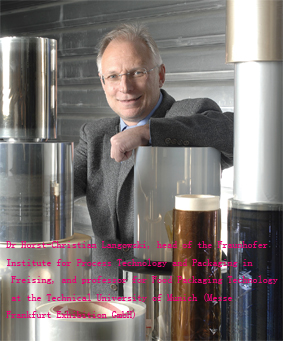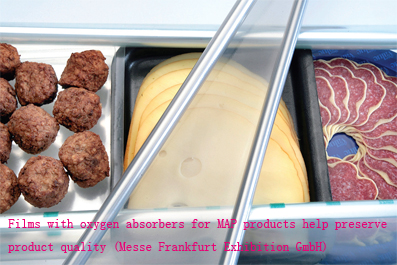
THE growth of the convenience product sector has had the greatest influence on the globally important meat and meat products sector, according the packaging expert Prof. Dr. Horst- Christian Langowski. " Butcher's shops and classic supermarket meat counters are being steadily replaced by the refrigerated sections of discounters [where] consumers are able not only to purchase processed meat products such as cooked and boiled sausages, but also pre-packaged fresh meats. Freshly cut meat, including spiced meats, sold in the refrigerated section make up a growing part of the convenience sector," says Prof. Dr. Langowski, who is director of the Fraunhofer Institute for Process Engineering and Packaging (IVV) in Freising, Germany, and holder of the Chair for Food Packaging Technology at the Technical University of Munich- Weihenstephan. Packaging plays an extremely important role in the convenience sector, Prof. Dr. Langowski claims, as without a suitable packaging concept, this sector could not even exist. "The desire for greater convenience is satisfied solely by the packaging. The use of modified atmosphere packaging (MAP) makes it possible to markedly increase the shelf life of meat products. Within the self-service market sector, fresh meats and sausages in plastic modified atmosphere packaging represent one of the fastest growing areas," he explains. Certain technical aspects must be watched particularly closely with MAP. "Even though we have been grouping fresh meats, meat and sausage products together in this discussion, there are actually very different requirements for each when it comes to the packaging and the protective gas to be used," he says. "In each case it is essential that the packaging materials used are able to provide a functional barrier against gasses. Otherwise, the composition of the gasses in the package headspace would be changed too much by the entry of other gasses." Products that have been processed differently place different demands on the packaging to be used. "As a result, the packaging concepts for sausages and fresh meats need to be dealt with separately. With closed packages, the colour and appearance of the meat products are a consumer's primary way of determining quality," he adds. Requirements that must be satisfied Modern packaging for meat products that are sensitive to the visible spectrum of light should contain a number of elements: a protective gas atmosphere that contains the technically feasible minimum of oxygen, high-barrier films that prevent the entry of oxygen and, in future, oxygen-absorbers that are able to absorb any residual oxygen remaining in the protective gas atmosphere or dissolved within the product itself as quickly as possible. "The objective is to use oxygen scavengers to remove this residual oxygen, so that it will be possible to sell consumers these products in the transparent packaging they desire, using the illumination that is standard in stores, all whilst maintaining an almost unchanging level of quality. These oxygen scavengers are currently being developed and tested. They are considered to be an example of active packaging. These are packaging materials made from conventional polymeric materials into which additional characteristics have been integrated," he says. Whilst standard packaging protects against oxygen in the air, moisture, light and infection by harmful organisms, he explains further, active materials are able to perform even more functions. In addition to consuming oxygen, examples include filtering out light and radiation from the near UV spectrum. 'The latest developments in packaging technology for meat and meat products are being driven by the demand for greater convenience'

"Antimicrobial packaging can provide additional protection against micro-organisms on the surface
Max 90 Winter Sneakerboot THE growth of the convenience product sector has had the greatest influence on the globally important meat and meat products sector, according the packaging expert Prof. Dr. Horst- Christian Langowski. " Butcher's shops and classic supermarket meat counters are being steadily replaced by the refrigerated sections of discounters [where] consumers are able not only to purchase processed meat products such as cooked and boiled sausages, but also pre-packaged fresh meats. Freshly cut meat, including spiced meats, sold in the refrigerated section make up a growing part of the convenience sector," says Prof. Dr. Langowski, who is director of the Fraunhofer Institute for Process Engineering and Packaging (IVV) in Freising, Germany, and holder of the Chair for Food Packaging Technology at the Technical University of Munich- Weihenstephan. Packaging plays an extremely important role in the convenience sector, Prof. Dr. Langowski claims, as without a suitable packaging concept, this sector could not even exist. "The desire for greater convenience is satisfied solely by the packaging. The use of modified atmosphere packaging (MAP) makes it possible to markedly increase the shelf life of meat products. Within the self-service market sector, fresh meats and sausages in plastic modified atmosphere packaging represent one of the fastest growing areas," he explains. Certain technical aspects must be watched particularly closely with MAP. "Even though we have been grouping fresh meats, meat and sausage products together in this discussion, there are actually very different requirements for each when it comes to the packaging and the protective gas to be used," he says. "In each case it is essential that the packaging materials used are able to provide a functional barrier against gasses. Otherwise, the composition of the gasses in the package headspace would be changed too much by the entry of other gasses." Products that have been processed differently place different demands on the packaging to be used. "As a result, the packaging concepts for sausages and fresh meats need to be dealt with separately. With closed packages, the colour and appearance of the meat products are a consumer's primary way of determining quality," he adds. Requirements that must be satisfied Modern packaging for meat products that are sensitive to the visible spectrum of light should contain a number of elements: a protective gas atmosphere that contains the technically feasible minimum of oxygen, high-barrier films that prevent the entry of oxygen and, in future, oxygen-absorbers that are able to absorb any residual oxygen remaining in the protective gas atmosphere or dissolved within the product itself as quickly as possible. "The objective is to use oxygen scavengers to remove this residual oxygen, so that it will be possible to sell consumers these products in the transparent packaging they desire, using the illumination that is standard in stores, all whilst maintaining an almost unchanging level of quality. These oxygen scavengers are currently being developed and tested. They are considered to be an example of active packaging. These are packaging materials made from conventional polymeric materials into which additional characteristics have been integrated," he says. Whilst standard packaging protects against oxygen in the air, moisture, light and infection by harmful organisms, he explains further, active materials are able to perform even more functions. In addition to consuming oxygen, examples include filtering out light and radiation from the near UV spectrum. 'The latest developments in packaging technology for meat and meat products are being driven by the demand for greater convenience'
THE growth of the convenience product sector has had the greatest influence on the globally important meat and meat products sector, according the packaging expert Prof. Dr. Horst- Christian Langowski. " Butcher's shops and classic supermarket meat counters are being steadily replaced by the refrigerated sections of discounters [where] consumers are able not only to purchase processed meat products such as cooked and boiled sausages, but also pre-packaged fresh meats. Freshly cut meat, including spiced meats, sold in the refrigerated section make up a growing part of the convenience sector," says Prof. Dr. Langowski, who is director of the Fraunhofer Institute for Process Engineering and Packaging (IVV) in Freising, Germany, and holder of the Chair for Food Packaging Technology at the Technical University of Munich- Weihenstephan. Packaging plays an extremely important role in the convenience sector, Prof. Dr. Langowski claims, as without a suitable packaging concept, this sector could not even exist. "The desire for greater convenience is satisfied solely by the packaging. The use of modified atmosphere packaging (MAP) makes it possible to markedly increase the shelf life of meat products. Within the self-service market sector, fresh meats and sausages in plastic modified atmosphere packaging represent one of the fastest growing areas," he explains. Certain technical aspects must be watched particularly closely with MAP. "Even though we have been grouping fresh meats, meat and sausage products together in this discussion, there are actually very different requirements for each when it comes to the packaging and the protective gas to be used," he says. "In each case it is essential that the packaging materials used are able to provide a functional barrier against gasses. Otherwise, the composition of the gasses in the package headspace would be changed too much by the entry of other gasses." Products that have been processed differently place different demands on the packaging to be used. "As a result, the packaging concepts for sausages and fresh meats need to be dealt with separately. With closed packages, the colour and appearance of the meat products are a consumer's primary way of determining quality," he adds. Requirements that must be satisfied Modern packaging for meat products that are sensitive to the visible spectrum of light should contain a number of elements: a protective gas atmosphere that contains the technically feasible minimum of oxygen, high-barrier films that prevent the entry of oxygen and, in future, oxygen-absorbers that are able to absorb any residual oxygen remaining in the protective gas atmosphere or dissolved within the product itself as quickly as possible. "The objective is to use oxygen scavengers to remove this residual oxygen, so that it will be possible to sell consumers these products in the transparent packaging they desire, using the illumination that is standard in stores, all whilst maintaining an almost unchanging level of quality. These oxygen scavengers are currently being developed and tested. They are considered to be an example of active packaging. These are packaging materials made from conventional polymeric materials into which additional characteristics have been integrated," he says. Whilst standard packaging protects against oxygen in the air, moisture, light and infection by harmful organisms, he explains further, active materials are able to perform even more functions. In addition to consuming oxygen, examples include filtering out light and radiation from the near UV spectrum. 'The latest developments in packaging technology for meat and meat products are being driven by the demand for greater convenience'  "Antimicrobial packaging can provide additional protection against micro-organisms on the surfaceMax 90 Winter Sneakerboot
"Antimicrobial packaging can provide additional protection against micro-organisms on the surfaceMax 90 Winter Sneakerboot
 iConnectHub
iConnectHub
 Login/Register
Login/Register Supplier Login
Supplier Login


























